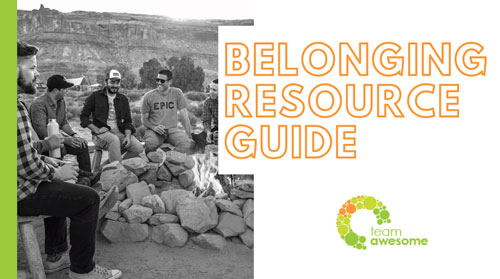Let’s talk about LOVE. More specifically, what love looks like at work. Now, some of the Human Resources people and the attorneys reading this are probably squirming in their seats right now. You may be thinking, “We don’t mix love and work!” That sounds like a lot of extra paperwork for you. Hear me out.
I believe we go to work in search of belonging. And that belonging feels safe, whole, and like love. It feels like home. If we want people to feel love, then humans have to come before stuff. So, what does love look like at work?
Love looks like this…
You spend time, energy, and passion towards people. Isn’t that really what love looks like with important people in your life? Time, energy, and passion. When things get challenging, people know you will be there and put humans first, over process or policy. Better yet, you build process and policy to put humans first.
I used to be the HR leader who supported policy until I understood the huge gap between the policies I was setting, and the experience I wanted in my own work. I remember sitting in a meeting at a large company, discussing leave of absence policies. The question up for discussion was whether or not employees should be eligible for leave of absence after 6 months, or in line with the federal requirement of 12 months. I said, “Wait… So what you’re telling me is that a woman could begin working here, become pregnant and then we would end their employment because they hadn’t yet been there 12 months?” Another leader responded, “Yes, but we would write them a really nice letter.” I’ll be honest, this did not feel like love. I pushed back. They picked 6 months.
When people don’t feel loved, what does that look like?
People sense they are just a cog in the wheel; that they are replaceable.
When there is no love, employees are psychologically unattached to their work and the company. Because their engagement needs are not being fully met, they’re putting time — but not energy or passion — into their work. And THAT is the nearly 70% of employees in the US that are not engaged (Gallup, State of the American Workplace Report). And why should they? If the organization does not put time, energy and passion towards people, why would we expect them to give it back?
To help people feel love, try this.
For your organization, try The Relationship Test. My friend and culture expert, Jason Lauritsen, has created this genius idea. Here’s how it works. Take any policy or practice that you use with your employees and imagine that you replicate that practice with a partner, or close friend. Would it help or harm the relationship? For example, If your onboarding program looks like three hours of paperwork and a review of all the many ways someone can get fired in the first ninety days, does this help or harm the relationship? Your friends and family wouldn’t appreciate that, and neither does your newly hired talent.
For yourself, try the “Just Like Me” practice. It is a practice in personal empathy. Here’s how it works. Think of someone you don’t understand or even like very well. You can picture someone right away, can’t you? You can do this with me by repeating this to yourself silently. Reframe your thoughts like this:
This person has beliefs, perspectives, and opinions, just like me.
This person has hopes, anxieties, and vulnerabilities, just like me.
This person has friends, family, and perhaps children who love them, just like me.
This person wants to feel respected, appreciated, and competent, just like me.
This person wishes for peace, joy, and happiness, just like me.
(Source: High-Performing Teams Need Psychological Safety. Here’s How to Create It, by Laura Delizonna, via HBR.org.)
Risks and Rewards
When we help people feel safe, loved and whole, fireworks can happen. People will stay at the company. They’ll take on big challenges, recruit their friends, and we hit our goals. There is a synergy greater than the sum of it’s parts. How do we measure that? Engagement. Your organization likely has measurements already in place that can be useful in measuring belonging, if we chose to view them through that lens.
But when we don’t use these ingredients, we erode connection. People will give us their time but will no longer give their energy or passion to work.
And for our organizations, we know the war for talent is too great to win by playing dead. You will lose. And quite frankly, we deserve better. In the not-so-distant future of work, where automation and AI take on our old work, our humanity will be the competitive advantage. Creative, heart and thought-based work will be what we need from our humans.
So, isn’t it time we show a little love in our organizations? In a non-creepy, totally appropriate, belonging-inducing way, that is. Help us want to give our time, energy, and passion to our work again. Employees are begging for proof of their belonging and purpose at work, so let’s use our organizational time, energy and passion to deliver on that, and watch the magic happen.
About the author:
Katie Rasoul is a keynote speaker, author, coach and Chief Awesome Officer for Team Awesome, a leadership coaching and culture consulting firm. She is a TEDx speaker alumna, author of the best-selling book, Hidden Brilliance: A High-Achieving Introvert’s Guide to Self-Discovery, Leadership and Playing Big, and co-host of The Life and Leadership Podcast.
To learn more about Katie’s signature keynote talk, “Beyond Diversity & Inclusion to Belonging,” visit www.katierasoul.com.


Recent Comments